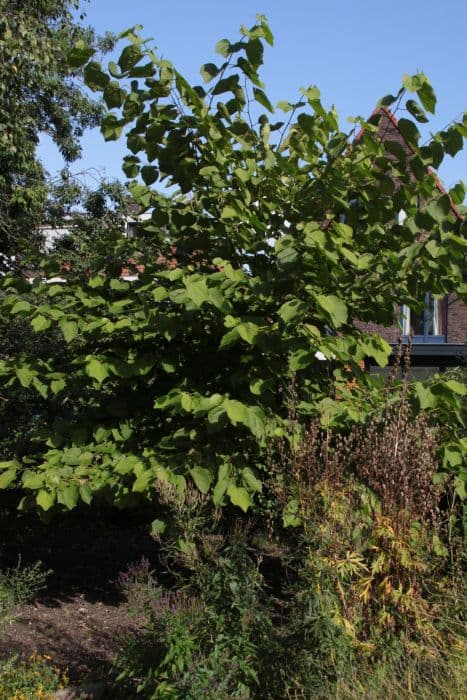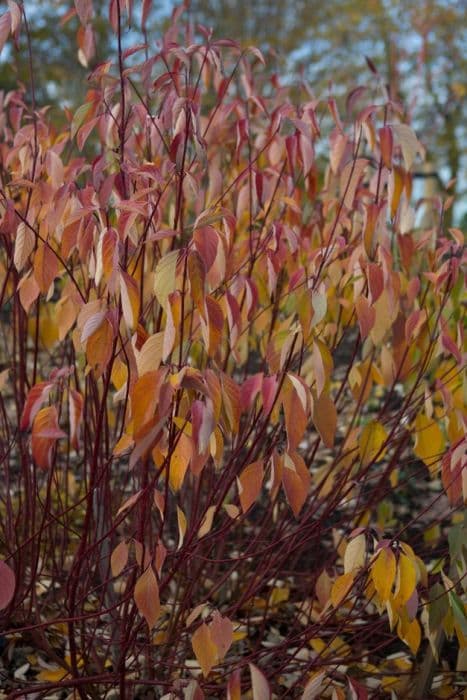Cornus mas











ABOUT
Cornus mas, commonly known as the Cornelian cherry, is a deciduous shrub or small tree that is notable for its multi-season interest. It has a rounded shape when mature, with a dense, twiggy branching structure. The leaves of the Cornelian cherry are opposite, meaning they grow in pairs on either side of the stem, and have a simple, ovate to oblong shape with smooth edges. They are a glossy green color during the growing season and can turn to a mixture of reddish-purple and yellow shades in the fall, adding to the plant's ornamental value. In late winter to early spring, before the leaves emerge, the Cornelian cherry produces an abundance of small, star-shaped yellow flowers that come in dense clusters along the branches. These flowers are quite showy and one of the first signs of spring in the landscape, providing a valuable early nectar source for pollinators. Following the flowering period, the plant produces edible oval-shaped drupes that resemble cherries. These fruits start out green, turning to a bright shiny red as they mature in late summer. The fruits are often used in jams, syrups, and liqueurs, and are also enjoyed by wildlife. The bark of the Cornelian cherry is an attractive exfoliating type that reveals a mix of brown and gray colors, giving it additional winter interest when the plant is leafless. Overall, the Cornelian cherry is beloved for its bright, early flowers, attractive summer fruits, colorful fall foliage, and interesting bark, making it a versatile plant for visual appeal throughout the year.
About this plant
 Names
NamesFamily
Cornaceae
Synonyms
Cornelian Cherry, Cornelian Cherry Dogwood, European Cornel, Cornelian Cherry Tree
Common names
Cornus mascula, Cornus erythrocarpa, Cornus vernalis
 Toxicity
ToxicityTo humans
Cornelian cherry, known scientifically as Cornus mas, is generally considered non-toxic to humans if ingested in the form of its ripe fruits. However, unripe fruits and other parts of the plant may contain higher levels of compounds that could potentially cause mild stomach upset if consumed in significant quantities.
To pets
For pets, the Cornelian cherry is also not regarded as highly toxic. Like many other plants, the consumption of non-fruit parts, especially in large amounts, may lead to gastrointestinal distress, such as vomiting or diarrhea, due to the presence of irritant substances. However, serious poisoning is unlikely. Owners should always be cautious when pets show interest in plants and consult a veterinarian if any abnormal signs occur after ingestion.
 Characteristics
CharacteristicsLife cycle
Perennials
Foliage type
Deciduous
Color of leaves
Green
Flower color
Yellow
Height
15 feet (4.57 meters)
Spread
15 feet (4.57 meters)
Plant type
Shrub
Hardiness zones
5
Native area
Europe
Benefits
 General Benefits
General Benefits- Ornamental Appeal: Cornus mas, commonly known as Cornelian cherry, is prized for its early spring blooms that offer bright yellow flowers before most other plants have started to wake up from winter.
- Edible Fruit: It produces small, cherry-like red fruits that are edible and can be used in jams, jellies, and preserves or eaten fresh.
- Drought Tolerance: Once established, Cornelian cherry is known for its ability to withstand periods of drought, making it suitable for xeriscaping.
- Cold Hardiness: It is tolerant of cold weather and can be grown in regions with harsh winters.
- Wildlife Attraction: The tree provides a food source for birds and other wildlife, which feed on its fruits.
- Longevity: This species is noted for having a long lifespan, contributing to landscape continuity and historical value.
- Erosion Control: With its extensive root system, Cornus mas can help stabilize soil and prevent erosion.
- Low Maintenance: Requiring minimal pruning and care once established, it is a good choice for gardeners seeking a low-maintenance landscape option.
- Seasonal Interest: It has a multiseasonal interest thanks to its attractive exfoliating bark that becomes visible after the leaves fall, making it a year-round feature in the garden.
- Suitable for Small Spaces: With a compact growth habit, it can be used in smaller gardens without overbearing the space.
 Medical Properties
Medical Properties- Antioxidant activity: Compounds in Cornus mas, such as anthocyanins and flavonoids, help to combat oxidative stress in the body.
- Anti-inflammatory properties: The fruit and other parts of the plant have been reported to alleviate inflammation.
- Antimicrobial effects: Extracts from Cornus mas demonstrate activity against certain bacteria and fungi.
- Astringent qualities: The bark and leaves have traditionally been used for their astringent properties to tighten and tone tissues.
- Diuretic action: It has been cited for promoting the production of urine, helping in the removal of excess fluids from the body.
- Febrifuge capabilities: Known for its potential to reduce fever, an application in traditional medicine.
- Liver protection: Contains compounds that may provide a protective effect on the liver.
- Immune system support: Potential to enhance the immune response, though specific mechanisms are not well-defined.
- Vision health: High in vitamin A and associated with supporting eye health.
 Air-purifying Qualities
Air-purifying QualitiesThis plant is not specifically known for air purifying qualities.
 Other Uses
Other Uses- Dye Production: The bark of Cornus mas can be used to produce a tannin-rich dye suitable for coloring textiles and leathers.
- Woodworking: The extremely hard and dense wood of Cornus mas, also known as cornelian cherry, is valued for crafting tool handles, machine parts, and small turned items.
- Wildlife Shelter: The dense foliage and branching habit provide excellent shelter and nesting sites for various bird species.
- Ink Ingredient: The fruit's juice, due to its rich pigment, can be employed as a component in natural ink formulations.
- Culinary Garnish: The brightly colored fruit can be used as an edible garnish for a variety of dishes, adding a vibrant touch to plating.
- Furniture Inlays: The wood's fine grain is ideal for creating decorative inlays in furniture and musical instruments.
- Hedging: With its dense growth and ability to withstand pruning, Cornus mas is often utilized for creating hedges and living fences.
- Arts and Crafts: The fruit and flowers can be used for making botanical prints or incorporated into decorative arrangements and wreaths.
- Traditional Musical Instruments: The wood's properties are suitable for making parts of some traditional musical instruments, such as flutes or pipes.
- Photography: The flowers of Cornus mas can be employed in the art of photography as subjects for macro photography due to their intricate detail.
Interesting Facts
 Feng Shui
Feng ShuiThe Cornelian cherry is not used in Feng Shui practice.
 Zodiac Sign Compitability
Zodiac Sign CompitabilityThe Cornelian cherry is not used in astrology practice.
 Plant Symbolism
Plant Symbolism- Renewal and Vitality: Cornelian cherry, the common name for Cornus mas, typically flowers in early spring, symbolizing the end of winter and the renewal of life.
- Good fortune and health: The vibrant fruit and flowers of the Cornelian cherry are often seen as symbols of prosperity and physical well-being.
- Protection: In some cultures, Cornelian cherry wood or fruit is believed to have protective properties, potentially warding off evil.
 Water
WaterFor a Cornelian cherry (Cornus mas), during the growing season, water the plant deeply once a week by providing about 1.5 gallons per square yard around the root area to ensure the soil is moist but not waterlogged. In hot and dry periods, increase the frequency to twice a week. Reduce watering in the fall, and in winter, only water if the soil is dry and there's no snow cover, using about 1 gallon per square yard every two weeks. It is important to avoid over-watering, which can lead to root rot.
 Light
LightThe Cornelian cherry (Cornus mas) thrives best in full sun to partial shade. Ideally, it should receive at least four hours of direct sunlight per day. A spot that offers morning sunlight with some afternoon shade is optimal, especially in regions with hot summers.
 Temperature
TemperatureThe Cornelian cherry (Cornus mas) is a hardy plant, tolerating temperatures down to -30 degrees Fahrenheit. It will actively grow in temperatures ranging from 60 to 75 degrees Fahrenheit. Avoid exposing the plant to temperatures above 95 degrees Fahrenheit for prolonged periods, as this can cause heat stress.
 Pruning
PruningPruning a Cornelian cherry (Cornus mas) is done to maintain shape and promote healthy growth. Prune in late winter or early spring before new growth starts. Remove dead or diseased wood, thin out crowded branches, and shape the plant as desired. Pruning can be done annually or as needed to manage the size and appearance of the plant.
 Cleaning
CleaningAs needed
 Soil
SoilCornelian cherry (Cornus mas) thrives in well-draining soil with a pH of 5.5 to 7.5. A mix of loam, peat, and sand is ideal, ensuring adequate drainage and fertility for healthy growth.
 Repotting
RepottingCornelian cherry (Cornus mas) usually does not require frequent repotting. In a landscape, repotting is not relevant, but if potted, repot every 3-5 years to refresh soil.
 Humidity & Misting
Humidity & MistingCornelian cherry (Cornus mas) prefers average garden humidity conditions and is quite adaptable, not needing any special humidity requirements.
 Suitable locations
Suitable locationsIndoor
Grow in bright light with moist, well-drained soil.
Outdoor
Plant in full sun to partial shade, well-draining soil.
Hardiness zone
4-8 USDA
 Life cycle
Life cycleThe life cycle of the Cornelian cherry (Cornus mas) begins with a dormant seed, which upon experiencing favorable conditions will germinate and spring forth as a seedling. The seedling then grows into a small sapling, focusing on establishing a strong root system and developing its first leaves and branches. As it matures into a juvenile tree, the Cornelian cherry enters a vegetative stage, characterized by vigorous growth in height and girth, until it achieves reproductive maturity. Upon reaching this stage, usually after several years, the Cornelian cherry produces clusters of small yellow flowers in late winter or early spring, which are pollinated by insects, leading to the development of distinctive, elongated red fruit in the summer. The fruits contain seeds that, once dispersed by animals or gravity, can give rise to new plants, thus continuing the propagation cycle. As the tree ages, it can live and remain productive for multiple decades, albeit with a gradual decline in growth and fruiting as senescence sets in.
 Propogation
PropogationPropogation time
Late winter
Cornelian cherry (Cornus mas) is commonly propagated through seed after the fruit has fully ripened, usually in early fall. The most popular method involves collecting the ripe berries, cleaning them to extract the seeds, and then stratifying them to overcome dormancy. Stratification is a process whereby the seeds are mixed with a moist substrate like peat moss and then stored in a refrigerator between 33-40 degrees Fahrenheit (0.5-4.4 degrees Celsius) for about 3-4 months. After this cold treatment, the seeds are sown in a nursery bed or pots where they will germinate come spring. It's crucial to maintain consistent moisture during germination and the early stages of growth. Once seedlings have developed enough to handle, they are typically transplanted to their permanent location.









